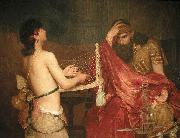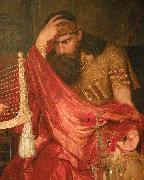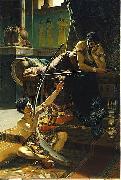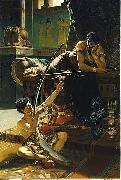
Oil On
Canvas, Real Flavor of Old Masters
|
Ernst Josephson
|
|||
|
|
|||
| 1851-1906 Swedish Ernst Josephson Gallery was a Swedish painter from a prominent Jewish family, whose main work was done on portraits and paintings of folk life. He did his art studies in Italy, France and the Netherlands, among others, and is reputed to have said at the age of 20: "I will become Sweden's Rembrandt or die." However, his life was marred by illness. He contracted syphilis at a relatively young age, and in 1888 he became mentally ill during a visit to Brittany, having religious hallucinations and believing that he was God and Christ. He was later taken to hospital in Uppsala and diagnosed with schizophrenia, but continued working throughout his disease, often while in a trance-like state. He also wrote poetry, in the collections Svarta rosor (1888, Black Roses) and Gula rosor (1896, Yellow Roses). His main work, Strömkarlen (1884, the Nix), was refused by the Swedish National Museum in Stockholm - however, Prince Eugen, Duke of Narke, bought the painting in fury over the decision. Grandfather of Erland Josephson. | |||
|
|
|||
|
|
David and Saul new24/Ernst Josephson-688936.jpg Painting ID:: 81083 Visit European Gallery |
Date 1878(1878) Medium Oil on canvas cjr | |
Height Width |
INS/CM |
||
|
X |
|
||
|
|
|||
|
Ernst Josephson
|
|||
|
|
|||
| 1851-1906 Swedish Ernst Josephson Gallery was a Swedish painter from a prominent Jewish family, whose main work was done on portraits and paintings of folk life. He did his art studies in Italy, France and the Netherlands, among others, and is reputed to have said at the age of 20: "I will become Sweden's Rembrandt or die." However, his life was marred by illness. He contracted syphilis at a relatively young age, and in 1888 he became mentally ill during a visit to Brittany, having religious hallucinations and believing that he was God and Christ. He was later taken to hospital in Uppsala and diagnosed with schizophrenia, but continued working throughout his disease, often while in a trance-like state. He also wrote poetry, in the collections Svarta rosor (1888, Black Roses) and Gula rosor (1896, Yellow Roses). His main work, Strömkarlen (1884, the Nix), was refused by the Swedish National Museum in Stockholm - however, Prince Eugen, Duke of Narke, bought the painting in fury over the decision. Grandfather of Erland Josephson. | |||
|
|
|||
|
|
David and Saul new25/Ernst Josephson-464893.jpg Painting ID:: 85145 Visit European Gallery |
1878(1878) Medium Oil on canvas cyf | |
Height Width |
INS/CM |
||
|
X |
|
||
|
|
|||
|
Julius Kronberg
|
|||
|
|
|||
| 1850-1921,Swedish painter and illustrator. He was educated at the Konstakademi in Stockholm, where his teachers were J. C. Boklund (1817-80), August Malmstr?m and Johan Fredrik H?ckert. In 1873 he travelled on a scholarship to D?sseldorf, and in the following year he went to Munich. There he was strongly influenced by the Old Masters (especially Rubens), as well as Hans Makart robustly theatrical style. Together they shaped Kronberg early works, for example Hunting Nymph and Fauns (1875; Stockholm, Nmus.), which caused a sensation when it was exhibited in Stockholm in 1876 and established his reputation. Kronberg left Munich in 1877 and settled in Rome, where, between trips to Egypt and Tunisia, he stayed until 1889, when he returned to Stockholm. During his years in Rome his style became increasingly austere. His exuberant Munich manner was replaced by a colder illusionism, which emphasized the historical details of subjects taken from the Bible and Shakespeare. Typical is David and Saul (1885; Stockholm, Nmus.), which reflected his study of Lawrence Alma-Tadema. | |||
|
|
|||
|
|
David and Saul new25/Julius Kronberg-975445.jpg Painting ID:: 85946 Visit European Gallery |
Date 1885(1885) Medium Oil on canvas Dimensions 298 x 220 cm (117.3 x 86.6 in) cjr | |
Height Width |
INS/CM |
||
|
X |
|
||
|
|
|||
|
Julius Kronberg
|
|||
|
|
|||
| 1850-1921,Swedish painter and illustrator. He was educated at the Konstakademi in Stockholm, where his teachers were J. C. Boklund (1817-80), August Malmstr?m and Johan Fredrik H?ckert. In 1873 he travelled on a scholarship to D?sseldorf, and in the following year he went to Munich. There he was strongly influenced by the Old Masters (especially Rubens), as well as Hans Makart robustly theatrical style. Together they shaped Kronberg early works, for example Hunting Nymph and Fauns (1875; Stockholm, Nmus.), which caused a sensation when it was exhibited in Stockholm in 1876 and established his reputation. Kronberg left Munich in 1877 and settled in Rome, where, between trips to Egypt and Tunisia, he stayed until 1889, when he returned to Stockholm. During his years in Rome his style became increasingly austere. His exuberant Munich manner was replaced by a colder illusionism, which emphasized the historical details of subjects taken from the Bible and Shakespeare. Typical is David and Saul (1885; Stockholm, Nmus.), which reflected his study of Lawrence Alma-Tadema. | |||
|
|
|||
|
|
David and Saul new25/Julius Kronberg-398454.jpg Painting ID:: 90134 Visit European Gallery |
1885(1885) Medium oil on canvas Dimensions 298 x 220 cm (117.3 x 86.6 in) cyf | |
Height Width |
INS/CM |
||
|
X |
|
||
|
|
|||










